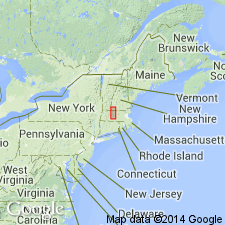- Usage in publication:
-
- Swanzey Gneiss*
- Modifications:
-
- Named
- Dominant lithology:
-
- Gneiss
- AAPG geologic province:
-
- New England province
Robinson, Peter, 1967, Progress report on bedrock geologic mapping in west-central Massachusetts: University of Massachusetts, Conference on Economic Geology in Massachusetts Proceedings, p. 29-47.
Summary:
Pg. 30. Swanzey Gneiss. Coarse-grained gneisses and related rocks below Ammonoosuc Volcanics and Partridge Formation are Pelham Gneiss, Monson Gneiss, Pauchaug Gneiss (new), Swanzey Gneiss (new), and Glastonbury Gneiss. Swanzey is similar to Pauchaug but with some zones resembling Monson Gneiss. As working hypothesis author suggests that at least a part of the rocks exposed below Middle Ordovician in west-central Massachusetts are Precambrian basement. If this hypothesis proves to be correct, then area must have been land during much of Cambrian and Early Ordovician time and may have been source area for sediments of this age deposited farther west.domes. Includes Cooleyville Granitic Gneiss (new). Older than Belchertown Intrusive Complex (new). Age is Devonian(?). Age is uncertain.
Unit is exposed in Keene Dome and extends into New Hampshire. Keene dome is in Bronson Hill anticline, [west-central Massachusetts], a complex zone of gneiss domes and recumbent folds, that lies near center of Appalachian tectonic belt of New England. Generalized axis of anticline in Massachusetts runs 3 to 5 miles east of Triassic border fault. The en echelon series of gneiss domes in the anticline are interrupted by the cross-cutting Belchertown Intrusive Complex.
Source: US geologic names lexicon (USGS Bull. 1350, p. 740-741); supplemental information from GNU records (USGS DDS-6; Reston GNULEX).

- Usage in publication:
-
- Swanzey Gneiss
- Modifications:
-
- Geochronologic dating
- AAPG geologic province:
-
- New England province
Summary:
Swanzey, Pauchaug, Monson, and Fourmile Gneisses represent metamorphosed intrusive igneous rocks and yield ages from 454 to 442+3/-2 Ma. Therefore, ages range from early Late through latest Ordovician. Authors suggest that they represent the plutonic root of a calc-alkaline magmatic arc at least 250 km long that was produced partly or entirely on a continental margin in the Late Ordovician. The overlying Ammonoosuc Volcanics and Partridge Formation, rather that resting unconformably on these plagioclase-rich plutonic gneiss, are now known to have had a magmatic history overlapping with them and are approximately the same age.
Source: GNU records (USGS DDS-6; Reston GNULEX).
For more information, please contact Nancy Stamm, Geologic Names Committee Secretary.
Asterisk (*) indicates published by U.S. Geological Survey authors.
"No current usage" (†) implies that a name has been abandoned or has fallen into disuse. Former usage and, if known, replacement name given in parentheses ( ).
Slash (/) indicates name conflicts with nomenclatural guidelines (CSN, 1933; ACSN, 1961, 1970; NACSN, 1983, 2005, 2021). May be explained within brackets ([ ]).

